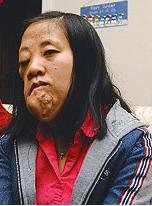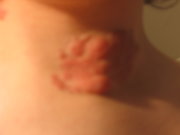Abstract
We describe a rare complication of stereotactic radiotherapy for large acoustic neuromas in a patient with type 2 neurofibromatosis. We retrospectively reviewed the case of a 14-year-old girl who had been referred to our tertiary care center. Prior to referral, the patient had been evaluated for hoarseness. During the work-up, magnetic resonance imaging (MRI) detected two large bilateral acoustic neuromas and two bilateral jugular foramen tumors. The patient was diagnosed with type 2 neurofibromatosis, and she underwent stereotactic radiotherapy for treatment of the two acoustic neuromas; the jugular foramen tumors were not irradiated. The patient's post-treatment course was complicated by hydrocephalus and symptoms of brainstem compression, which required urgent surgical intervention. Follow-up MRI 7 months following radiotherapy demonstrated a rapid growth of the acoustic neuromas, but no appreciable change in the size of the jugular foramen neuromas. These findings suggest that the radiotherapy might have been the cause of the rapid growth of the acoustic neuromas. To our knowledge, no such report has been published in the literature, and this phenomenon might be unique. Our findings suggest that radiotherapy might not be the optimal first-line treatment for acoustic neuromas in patients with type 2 neurofibromatosis.
Introduction
Stereotactic radiotherapy has been advocated as an alternative to microsurgical removal of acoustic neuromas. Gamma units, linear accelerators, and cyclotron accelerators have all been used to generate a focused radiation beam directed at the center of the targeted tumor. In 1971, Leksell was the first to report the efficacy of this technique. (1) Since then, several authors have described the outcomes of patients whose acoustic neuromas were treated in this manner. (2-4) They reported that the complication rates associated with stereotactic radiotherapy with regard to facial palsy and hearing loss were similar to those seen with microsurgical techniques.
Stereotactic radiotherapy has also been used for the treatment of bilateral acoustic neuromas in patients with type 2 neurofibromatosis (NF2). The reported rate of hearing preservation in these patients appears to be better than that seen with microsurgical resection. (5) However, data on long-term follow-up and detailed post-treatment complications are lacking.
In this article, we report a rare--perhaps unique--case of rapid tumor growth following stereotactic radiotherapy in a patient with NF2. A comparison of the growth rates of the patient's treated acoustic neuromas with the growth rates of the adjacent untreated jugular foramen neuromas strongly suggests that irradiation might have been the cause of the rapid growth of the former. The patient's postirradiation course was also fraught with a series of complications, which illustrates the sometimes difficult nature of stereotactic radiotherapy.
Case report
A previously healthy 14-year-old girl had been evaluated for hoarseness. A right vocal fold impairment was noted on physical examination. Magnetic resonance imaging (MRI) detected multiple intracranial lesions that were consistent with NF2. There were two bilateral acoustic neuromas, which measured 1.5 x 2.0 cm on the left and 1.0 x 1.5 cm on the right, and two bilateral jugular foramen neuromas, which measured 1.5 x 1.5 cm on the left and 1.0 x 1.0 cm on right (figure 1). Shortly after the MRI results were reviewed, the patient was referred to our tertiary care center.
Surprisingly, audiometric testing revealed that the patient's hearing was normal; on the right, her speech reception threshold was 0 dB and her speech discrimination score was 96%; the corresponding figures on the left were 5 dB and 96%. The surgeon recommended microsurgical removal of the larger left cerebellopontine angle lesion and concurrent decompression of the left jugular foramen tumor. However, the patient's family chose stereotactic radiotherapy instead. A total of 22 Gy was delivered in fractionated doses to both cerebellopontine angle masses; the dose to the tumor periphery averaged 18 Gy. The jugular foramen lesions were spared.
Three months following stereotactic radiotherapy, the patient developed hydrocephalus, which required placement of a ventriculoperitoneal shunt. Seven months after radiotherapy, the patient returned with acute lethargy, ataxia, confusion, and hallucinations. MRI examination revealed that the acoustic neuromas had grown markedly and measured 2.5 x 3.5 cm on the left and 2.0 x 2.0cm on the right (figure 2). The size of the jugular foramen neuromas remained stable, measuring 1.6 x 1.5 cm on the left and 1.0 x 1.0 cm on the right. Moreover, the brainstem compression was noted to have increased significantly compared with the findings on the initial MRI.
The patient underwent emergency surgery via a left suboccipital approach to decompress the enlarged tumor and to relieve the brainstem compression. However, during manipulation of the tumor, the patient went into cardiac arrest. She was resuscitated, and the procedure was terminated. Four days later, she was returned to the operating room for successful debulking of the tumor from the brainstem. Pathologic analysis revealed viable tumor cells that were consistent with acoustic neuroma.
Postoperatively, extubation failed, and the patient developed right lower lobe pneumonia. Despite aggressive medical therapy, she developed sepsis and died on postoperative day 6.
Discussion
This case represents an unusual outcome of radiotherapy: an accelerated growth of acoustic neuromas. The expected outcome following radiotherapy for sporadic acoustic neuromas is cessation of tumor growth, which has been reported to have occurred in 43 to 74% of cases over a 3-year follow-up. (5-10) Continued slow growth was reported in up to 12% of cases. (5,7,8)
Only a few studies have focused on the efficacy of radiotherapy in NF2 patients who have bilateral acoustic neuromas. A direct comparison of the response rates in NF2 patients and non-NF2 patients suggests that NF2 patients are twice as likely to experience slow persistent tumor growth after radiotherapy (12 vs 24%). (8)
Rapid growth of an acoustic neuroma following radiotherapy has not been reported to date. This case suggests the possibility that the rapid growth seen in our patient was actually induced by radiotherapy. Supporting this hypothesis is the fact that the nonirradiated jugular foramen neuromas--which are histologically similar to acoustic neuromas--grew only minimally during the same time.
This case also illustrates the potential danger of using radiotherapy to treat NF2-associated acoustic neuromas that are compressing the brainstem. The proximity of these tumors to the brainstem indicates that any tumor expansion will result in further brainstem compression and significant morbidity. Slight tumor expansion following radiotherapy has been observed within 6 months of therapy. (11) In this respect, the presence of bilateral acoustic neuromas in NF2 patients would confer a higher risk of further brainstem compression. Additionally, radiotherapy for NF2-associated acoustic neuromas is associated with a higher rate of persistent tumor growth than is radiotherapy for sporadic acoustic neuromas. (8) These two factors argue against the use of radiotherapy as the primary treatment modality for NF2 patients with acoustic neuromas that are already compressing the brainstem. Stereotactic radiotherapy is not necessarily a benign treatment for these patients.
References
(1.) Leksell L. A note on the treatment of acoustic tumours. Acta Chir Scand 1971;137:763-5.
(2.) Ito K, Kurita H, Sugasawa K, et al. Neuro-otological findings after radiosurgery for acoustic neurinomas. Arch Otolaryngol Head Neck Surg 1996;122:1229-33.
(3.) Kondziolka D, Lunsford LD, McLaughlin MR, Flickinger JC. Long-term outcomes after radiosurgery for acoustic neuromas. N Engl J Med 1998;339:1426-33.
(4.) Noren G. Long-term complications following gamma knife radiosurgery of vestibular schwannomas. Stereotact Funct Neurosurg 1998;70(Suppl 1):65-73.
(5.) Subach BR, Kondziolka D, Lunsford LD, et al. Stereotactic radiosurgery in the management of acoustic neuromas associated with neurofibromatosis type 2. J Neurosurg 1999;90:815-22.
(6.) Foote RL, Coffey RJ, Swanson JW, et al. Stereotactic radiosurgery using the gamma knife for acoustic neuromas. Int J Radiat Oncol Bio Phys 1995;32:l153-60.
(7.) Kwon Y, Kim JH, Lee DJ, et al. Gamma knife treatment of acoustic neurinoma. Stereotact Funct Neurosurg 1998;70 (Suppl l):57-64.
(8.) Noren G, Greitz D, Hirsch A, Lax I. Gamma knife surgery in acoustic tumours. Acta Neurochir Suppl (Wien) 1993;58:104-7.
(9.) Flickinger JC, Lunsford LD, Coffey RJ, et al. Radiosurgery of acoustic neurinomas. Cancer 1991;67:345-53.
(10.) Noren G, Greitz D, Hirsch A. Gamma knife radiosurgery in acoustic neurinoma. In: Steiner L, ed. Radiosurgery: Baseline and Trends. New York: Raven Press, 1992:141-8.
(11.) Kobayashi T, Tanaka T, Kida Y. The early effects of gamma knife on 40 cases of acoustic neurinoma. Acta Neurochir Suppl (Wien) 1994;62:93-7.
From the Department of Otolaryngology, Northwestern University School of Medicine, Evanston, Ill. (Dr. Ho), and the Department of Surgery, Yale University School of Medicine, New Haven, Conn. (Dr. Kveton).
Reprint requests: Steven Y. Ho, MD, Department of Otolaryngology. Northwestern University School of Medicine, 1000 Central St., Suite 610, Evanston, IL 60202. Phone: (847) 570-1360; fax: (847) 733-5360; e-mail: syh_me109g@yahoo.com
COPYRIGHT 2002 Medquest Communications, LLC
COPYRIGHT 2003 Gale Group




